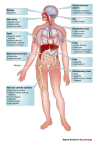Developing animal models for polymicrobial diseases
- PMID: 15197391
- PMCID: PMC7097426
- DOI: 10.1038/nrmicro928
Developing animal models for polymicrobial diseases
Abstract
Polymicrobial diseases involve two or more microorganisms that act synergistically, or in succession, to mediate complex disease processes. Although polymicrobial diseases in animals and humans can be caused by similar organisms, these diseases are often also caused by organisms from different kingdoms, genera, species, strains, substrains and even by phenotypic variants of a single species. Animal models are often required to understand the mechanisms of pathogenesis, and to develop therapies and prevention regimes. However, reproducing polymicrobial diseases of humans in animal hosts presents significant challenges.
Conflict of interest statement
The author declares no competing financial interests.
Figures






References
-
- Brogden KA, Guthmiller JM. Polymicrobial diseases, a concept whose time has come. ASM News. 2003;69:69–73.
-
- Smith H. The role of microbial interactions in infectious disease. Philos. Trans. R. Soc. Lond. B Biol. Sci. 1982;297:551–561. - PubMed
-
- Jakab GJ. Mechanisms of bacterial superinfections in viral pneumonias. Schweiz Med. Wochenschr. 1985;115:75–86. - PubMed
-
- Hament JM, et al. Respiratory viral infection predisposing for bacterial disease: a concise review. FEMS Immunol. Med. Microbiol. 1999;26:189–195. - PubMed
-
- McCullers JA, Tuomanen EI. Molecular pathogenesis of pneumococcal pneumonia. Front. Biosci. 2001;6:D877–D889. - PubMed
Publication types
MeSH terms
LinkOut - more resources
Full Text Sources
Other Literature Sources
Medical

